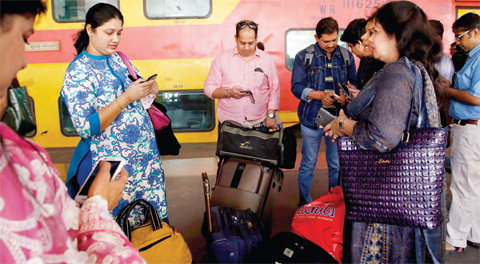 MUMBAI: Indian travellers use a free WiFi service to browse the net at Mumbai Central Train Station in Mumbai on Friday. Google Inc has begun offering free WiFi to Mumbai train passengers in hopes of boosting its role in the Indian market, the first of 400 stations the company plans to eventually reach with the service. — AP
MUMBAI: Indian travellers use a free WiFi service to browse the net at Mumbai Central Train Station in Mumbai on Friday. Google Inc has begun offering free WiFi to Mumbai train passengers in hopes of boosting its role in the Indian market, the first of 400 stations the company plans to eventually reach with the service. — AP
MUMBAI: Google Inc has begun offering free Wi-Fi to Mumbai train passengers in hopes of boosting its role in the Indian market. Giggling groups of students, bored commuters and snack-shop vendors were all logging on Fr iday at Mumbai Central Train Station, the first of 400 stations the company plans to eventually reach with the service. “If my train is leaving, and I need to search, don’t know where to go, then immediately I will get the answer,” student Divya Patel said excitedly while waiting for a train to her hometown of Ahmedabad in the western state of Gujarat. “This is very good, and good for everyone.” Free Wi-Fi is rare across India. Most of the country’s 300 million Internet users pay for personal access and often rely on slow-loading smartphone connectivity. With a massive 1.25 billion population in India, including 6 million new Internet users every month, Silicon Valley tech giants such as Google, Facebook and Microsof t have set sights on expanding in the Indian market.
Online retailers Amazon and eBay have also launched services in the country. India also has homegrown online commerce companies but small businesses are still catching on. Fewer than 5 percent of the 50 million or so small businesses in India have a web page. With more than 23 million people riding Indian railways every day, Google said free Internet in train stations will give high-speed access that many can’t afford.
It also hopes to diversify India’s user base, given that less than a third of Internet users in India are women, and has been upgrading its services in Hindi and other languages spoken across India. “Most of India is still not online,” Google CEO Sundar Pichai told repor ters last month in New Delhi. “We want to bring access to as many people as possible,” he said. For the project, Google teamed up with Indian Railways as well as communications infrastructure provider RailTel. — AP

